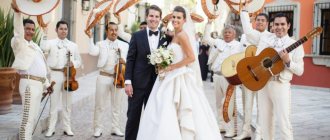A Spanish wedding is a unique celebration in which modern trends are closely intertwined with ancient traditions and customs, characteristic only of the inhabitants of this country. They are a reflection of the passionate Spanish soul, hot temperament and devotion to family values. This is what distinguishes celebrations in hot Spain from the rather restrained European weddings that everyone is accustomed to.
The Svadbaholik.ru portal offers a closer look at the unique customs and features of holding a wedding in bright and sunny Spain. Depending on the region of the country, traditions may differ from each other, but the basics of celebrations comply with established rules.
Spanish wedding dresses
Wedding traditions in Spain affect not only the ceremony, but also the choice of dress for the bride, which, by the way, is usually bought by the groom.
According to all the most ancient canons, the classic bride's dress should be black. In Spain, this color symbolizes love and devotion to one's husband until death. However, not everyone likes this now! Some girls, following custom, buy a white dress for themselves, but add black elements to it.
Most often, modern brides prefer a white outfit, less often - red. Many girls choose a wedding dress in the traditional Spanish style - flamenco, the distinctive features of which are both the style and the unusual diagonal cut. The fitted top of the dress, a fluffy skirt and an abundance of flounces emphasize the silhouette and add uniqueness to the bride’s image.
The founders of flamenco are the Spanish gypsies. As a result of the interaction of two cultures and traditions, an unsurpassed, vibrant and unique style emerged. Perhaps this is why the Spaniards celebrate weddings so magnificently and on a grand scale.
One of the most important details of a Spanish wedding look is the traditional lace veil - mantilla, which looks incredibly gentle and romantic.
Bride's image for a wedding in Spain
Spanish wedding dresses are spectacular and luxurious, which sizzling beauties can easily afford, given their fiery temperament and bright appearance. The portal for newlyweds Svadebka.ws will tell you about the main trends in creating the image of a Spanish bride:
- A tribute to tradition. Despite the fact that Spanish brides increasingly prefer modern and fashionable European dresses, many of them try to choose something traditional for the celebration. Designers are happy to work on creating wedding dresses in the old Spanish style, where there are flamenco elements - ruffles, ruffles and bright colors. Also a tribute to customs is the choice of a classic Spanish outfit in black: unusual, but very traditional.
- Models of dresses. Spanish designers work on creating a wide variety of dress models, however, most of them try to stick to one concept - a V-neck and a fitted top, which makes the bride's silhouette especially elegant and attractive.
- Accessories. An important detail of the bride’s image is considered to be a traditional Spanish accessory called a “mantilla” - a long veil trimmed with lace. Brides can also use combs and large flowers to decorate their hair. If you want to choose a bright and stylish accessory for yourself, you can watch how wealthy Spanish gypsies celebrate their wedding, in whose images there is a large amount of gold jewelry and precious stones.
Spanish style wedding
Imbued with the spirit and traditions of a bright and sunny country, newlyweds from all over the world often want to add these special notes to their celebration. A Spanish-style wedding will be remembered for a long time not only by the young people, but will also leave pleasant memories for all guests. Good and interesting traditions will only brighten the holiday of love.
A wedding filled with touching rituals elevates the celebration to a sacred level. The symbolism of love and happiness surrounds the young. A riot of colors and fireworks of emotions create a unique atmosphere. The scale of the celebration in the Spanish style will not leave anyone indifferent.
To organize such a unique wedding, you don’t have to go to Spain. You just need to borrow the interesting traditions you like, add bright decorations, choose a themed wedding dress in the flamenco style - and your unforgettable holiday is ready!
The portal www.svadbagolik.ru is confident that anyone can organize a wedding even in the most unusual style, and a piece of magnificent Spain will make your holiday truly colorful and unique.
Spanish wedding traditions
Today, a wedding in a certain style is not new to anyone. You can triple your wedding by sticking to a specific color: mint, yellow, orange, pink, and so on. You can have a wedding in the style of Gothic, Provence, rustic, etc. Or you can... in the Spanish style!
But to have a real Spanish wedding, you can go to the country itself, or you can get acquainted with real Spanish traditions and celebrate an Espaniol wedding in Russia 
So, I introduce you to the wedding traditions of Spain.
Of course, the first is a sentence (pedir la mano).
According to custom, the groom's parents (los padres del novio) come to the house of the bride's parents (lospadres de la novia). All expenses used to be borne by the groom's family. On the morning of this day, the groom must send his chosen one a bouquet (el ramo) of white flowers.
The purpose of this meeting is to introduce families who are about to become related (emparentar) over lunch, dinner or just a cup of tea/coffee. Sometimes this event takes place in a restaurant, sometimes at home. The bride's parents sit at the head of the table, and the groom's parents sit to their right (the groom's mother is to the right of the bride's father, and the groom's father is to the right of the bride's mother).
On this day, future spouses exchange gifts in the presence of guests. Moreover, no one else should give gifts on this day. The groom, as a rule, gives his chosen one a ring (el anillo) with a diamond (or without). And the bride gives the groom a watch (el reloj), cufflinks (los gemelos) or a tie clip (el alfiler de corbata).
Wedding rings (las alianzas) are an integral symbol of marriage. The ring finger (eldedo anular) is said to be directly connected to the heart. The vein connecting them was considered the vein of Love back in Greece.
Even in Spain, the groom traditionally gives the bride 13 blessed coins (las arras) made of gold or silver measuring 1.5-3 mm in diameter. They once symbolized the groom's ability to feed his future family, or it was a ransom for her virginity. Now it is simply a symbol of the common property of the spouses. Sometimes coins are not bought, but received as a gift from the godmother (la madrina) or as an inheritance from the parents of the bride or groom.
A few days before the wedding, the bride and groom usually have a bachelorette party (la despedida desoltera)
and the bachelor party (la despedida de soltero), respectively.
Few people now observe the tradition of collecting a dowry (eldote) for the bride.
By the way, in Spain, weddings do not take place on Tuesday 13th (martes, trece), as this day is considered unlucky. Let us remember the saying: “Martes y trece, ni te cases, ni te embarques” (Tuesday the 13th, neither get married, nor leave).
There is a custom to take eggs to the Clarissa nuns (llevar huevos a las Clarisas) so that there will be good weather on the wedding day.
It is believed that the bride should wear white (blanco) because they used to marry as virgins, and white is a symbol of purity and purity.
By the way, in Andalusia, many girls choose a long dress in the flamenco style: with frills (volantes) at the bottom and a short bolero (abrigo corto de bolero).
But a 100% Spanish dress should be made of black silk (seda negra).
A traditional detail of a wedding dress (since the 17th century) is a lace cape (la mantilla de encaje) - a “mantilla”, which the bride pins to her hair with two black combs (peines negros). It is often longer and heavier than a regular veil (el velo).
Before the wedding, the bride used to embroider (border) a shirt, which her future husband would wear to the ceremony.
On your wedding day, you should definitely wear something blue or dark blue (azul), something rented (prestado) and something old (usado). Blue symbolizes fidelity, strong long-term relationships. What is borrowed for a while symbolizes friendly ties. And a used, not new thing symbolizes that we do not forget the past, but remember it.
In Spain, not a single wedding is complete without orange blossom (el azahar) - white flowers (orange tree). The bride inserts them into her hair, they are present in the bouquet, as well as in flower arrangements on the banquet tables.
At a wedding, it is customary for the godfather (el padrino) to give a small gift to the male guests, usually a cigar (el puro). And the godmother (la madrina) gives some gift to the ladies present (previously it was cigarettes). For the unmarried girls who come, the bride prepares small brooches (el broche) with flowers, which they wear during the holiday: whoever loses it will marry next. Children are given treats or trinkets (chucher?as).
When leaving the church, the newlyweds are sprinkled with rice (arroz) - this tradition came from Asia, and symbolizes hope for offspring.
The wedding ball usually opens with the dance of the newlyweds - the waltz (el vals). Some adhere to the tradition that first the groom dances with his godmother, and the bride with her godfather.
The bouquet (el buquet = el ramo) thrown by the bride to her friends who have reached marriageable age (casaderas) is a good way to share her happiness. The tradition originates in France; in the 14th century, it was believed that the garter (la liga) brings good luck, and so that all the guests would not chase after it, the bride began to throw it voluntarily. Then gradually the custom arose of throwing a bouquet to girls and a garter to boys.
The wedding cake (la tarta nupcial) came to us from Rome. Previously, a piece of bread was placed on the bride's head - a symbol of fertility and offspring. And the guests treated themselves to the pieces that fell. A multi-tiered wedding cake is already an English tradition.
The groom crosses the threshold of the house with the bride in his arms (cruzar la puertacon la novia en brazos), and the right foot must step first. They say that this tradition comes from the Goths, who, due to the lack of women in their settlement, “stole” them from neighboring villages, taking them away on horseback.
Honeymoon (la luna de miel) and honeymoon trip (el viaje denovios) - what would we do without them? Do you know why this is the honeymoon? The Teutones (los teutones) celebrated weddings under the moon (moon) and drank honey liqueur for several days after the wedding to restore strength.
A few days after the wedding, the newlyweds (los recien casados) can receive their Family Book (Libro de Familia - a legal document with information about the marriage) at the registry office (Registro Civil), and their future children will also be entered there.
Be happy!
Photos and materials from the Internet
Wedding ceremony in Spain - bureaucratic nuances
Spaniards love weddings. They generally love holidays. Fiesta ! They prepare for them, saving money for years, so that they can spend it literally in the evening. You may not learn frugality from the Spaniards, but they know well how to celebrate weddings.
One of the advantages of getting married in this sunny country is that the Spaniards, whom you will have to meet and interact with during your celebration, will most often give you “compliments” on the occasion of your event: restaurants will treat the newlyweds to the best wine from the collection, florists will definitely add something floral interesting at your discretion and free of charge, hotels will provide a more expensive room and organize a free treat for the newlyweds.
Even people on the street will strive to give the bride and groom, if not a symbolic souvenir, then at least a good wish and a dozen kisses
Experts say that there are two options for a wedding celebration for Russians in Spain:
- Official ceremony . It is carried out by the Russian consul, and a Russian marriage certificate is issued. This procedure can only be done by newlyweds who have spent more than 40 days in Spain. It is very convenient for people who are on a long vacation in the country, study at local universities or run a business there. It is necessary to provide a package of documents to the municipality (birth certificate, internal and international passport, certificate of residence, application for marriage + copies of these documents in Spanish). 30 days after submitting the papers, the marriage will be registered.
- Symbolic ceremony . The marriage is registered by the newlyweds on the territory of the Russian Federation, and in Spain only the solemn part is held. This procedure is less bureaucratic and does not require litigation with documents. Everything depends only on the flight, hotel, restaurant, photographer and other services. In fact, this is the ideal option to combine celebration and honeymoon: your favorite beach for the celebration, and then !vamos! explore the country further.
To make the symbolic ceremony more real, religious couples can have a wedding ceremony in a Spanish church (boda de la iglesia). Although even here you cannot do without documents: a marriage certificate, a baptismal certificate of the newlyweds, a declaration that they have not previously been married and a document stating that they are not relatives by blood + an official translation into Spanish.











